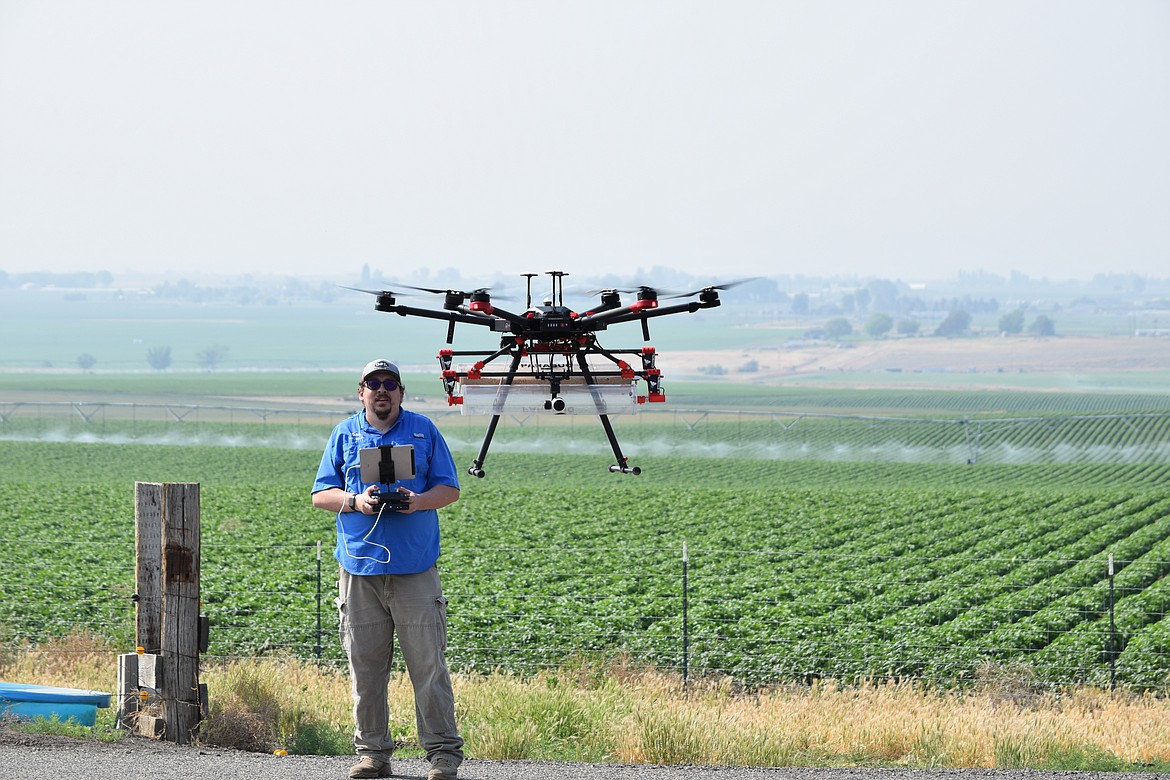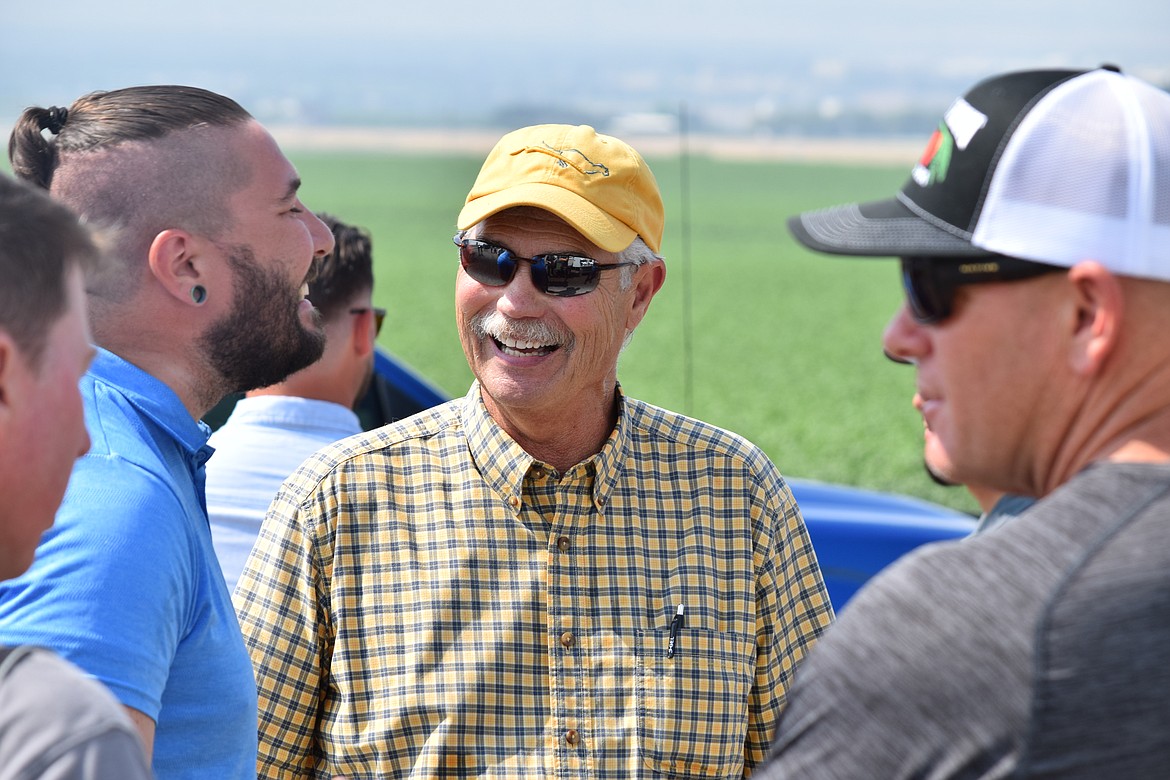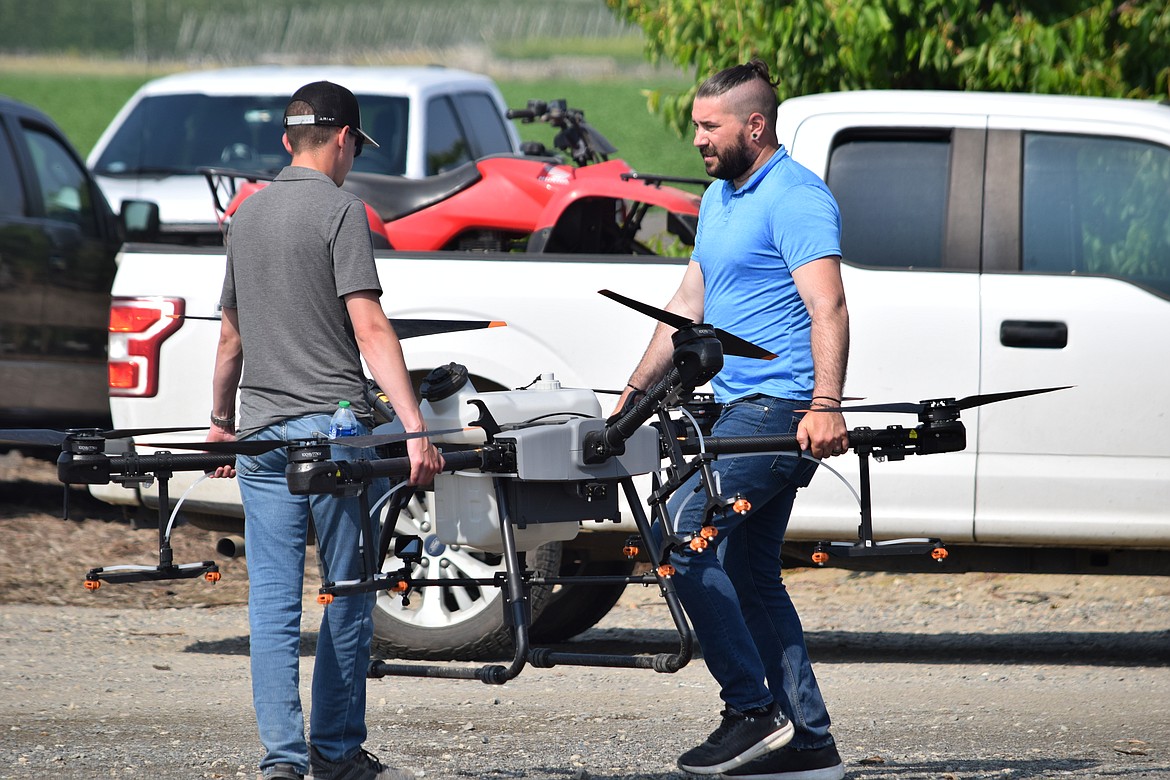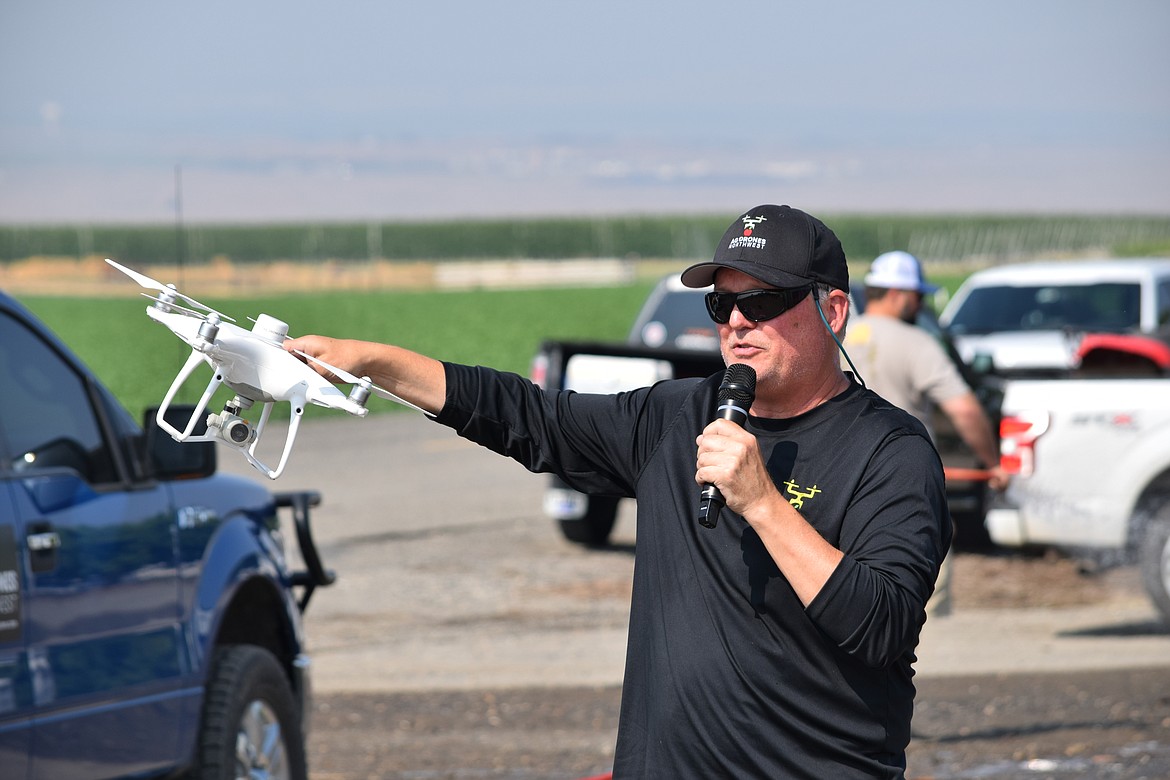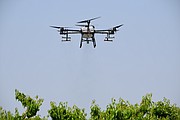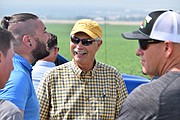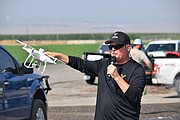Flying into a niche: Farmers still looking for that perfect use for ag drones
PASCO — According to Lav Khot, an agricultural drone is just another piece of farm machinery.
“A drone is nothing but a tractor,” Khot said. “It’s really a platform that you can attach anything to.”
It’s a hot Friday morning in a cherry orchard just north of Pasco, and Khot, the director of Washington State University’s AgWeatherNet and specialist in precision agriculture, is standing with several dozen interested farmers and a handful of business owners showing off drones of various sizes and capabilities.
The event was billed as Spring Drone Day, organized and sponsored by WSU Extension, the Washington Tree Fruit Research Commission, and AgAID Institute, an agricultural technology research initiative based at WSU but involving a number of businesses and universities from across the United States, including Oregon State University, the University of Virginia, Kansas State University, IBM and Walla Walla-based agricultural systems company Innov8.ag.
Showing off their wares at the Hayden Orchard, which hosted the event, were representatives from Richland-based Altitude Agri Services, Cle Elum-based Ag Drones Northwest, Union Gap-based G.S. Long Company, and Issaquah-based Tyton Aviation.
“We have been doing drone workshops and data analytics and all those things, but because of COVID we stopped,” Khot said. “And now we wanted to start somewhere. … (We said) let’s do this, let’s see how much interest there is from growers.”
Khot said a lot of farmers are sitting on the fence about drones, and hopes that events like Drone Day can help growers see both how useful drones are now and their potential for even greater uses in the future, especially as farm labor becomes more difficult to find
“We want to have a meaningful adoption of this for growers, and education like this is vital for all that,” he said.
More than just pretty pictures
Not too long ago, drones were limited to imaging and mapping, Khot said. Those were important uses, allowing farmers to use cameras and sensors to make precision maps of their land, soil types, nutrient needs, plant health and even how much water is being used, where it might be needed and where it might be wasted.
“With those sensors, you can see something that our eyes cannot see and you can really get some good information about crop health,” he said. “It won’t tell what is causing that, but it will tell you there is some issue that you can do additional scouting and search for.”
All of those uses are still important, Khot said, because they give farmers the information they need to act. But as drones have gotten larger, they can take on more tasks, such as precision spraying, releasing beneficial insects or even rotors to dry off trees.
However, companies providing drone services — and most are focusing on providing services with drone fleets rather than selling the drones themselves — are engaging in a lot of trial and error to figure out how drones are useful in agriculture.
“I was a consultant for most of my life, and the technology thing has always been of interest,” said Jeff Allen, director of field support and technology for G.S. Long, an agricultural drone service company based in Union Gap with operations in both Washington and Oregon. “But turning it into something that really makes sense and fits in our business has been tricky.”
Allen said G.S. Long is finding its greatest success in using drones to make incremental improvements, such as going where it is too difficult, expensive or time-consuming for people to go easily or safely, such as steep hillsides in orchards or vineyards, or chemical spraying that doesn’t put workers at risk.
“You’d look at all the ads, and you’d hear people talk about it, that this is going to revolutionize the industry. And it hasn’t,” Allen said. “Not yet.”
Among the better uses the company has found for its larger drones is the dispersal of beneficial insects like the lacewing in orchards and vineyards, said Aaron Avila, head of growers services for G.S. Long. At the Drone Day event, G.S. Long showed how one of its larger drones dispersed lacewing eggs along with chaff over cherry trees. The chaff gives the bugs, whether they are lacewings, ladybugs, or whatever they might be, something to grasp onto as the system disperses them, Avila said.
“We can get a much more even distribution that doesn’t require two hands and we can do it a lot faster,” he said.
Bill Kuper, founded and chief pilot of Ag Drones Northwest, said most agricultural drones in service right now are made in China by DJI Drones in Shenzhen, China. Most have settings that allow them to return to their home base when their power gets too low, or if whatever they are dispersing or spraying gets too low as well.
He pointed to a large, six-rotor DJI drone he called a T-30, which refers to the 30-liter tank of liquid the drone can disperse from its collection of attached nozzles and sprayers. Kuper said a drone like the T-30 can fly for anywhere from 10-15 minutes, depending on wind conditions and the speed at which it is flying or spraying. A drone like this might cost as much as $30,000, Kuper said, but a fast charger and multiple batteries will help keep the done in the air as much as possible.
“It’s like a NASCAR pit stop,” he said. “You land, you fill the tank, you swap the battery at the same time even if the battery has 40% left on it. … With a generator that can fast charge, you need a 10,000-watt generator, it can recharge them as fast as you use them. And that’s the whole key.”
Learning to fly
Finding drone pilots is easy, according to Kurt Beckley, the owner of Altitude Agri Services.
“If you want to know where to find people, hire ex-military guys that have flown drones for the majority of their career. Those guys can. And kids can as well. You know, it’s the video game thing,” Beckley said.
In fact, Jake Schraeder, a smart farming technician with WSU in Prosser, said most drone control interfaces are fairly simple, and that WSU trains its graduate students by simply handing them a drone control and telling them to fly.
“Any kid who grew up playing video games would get it pretty quickly. It’s fairly intuitive,” he said.
Unlike in video games, however, a typical ag drone is real, and very costly, and doesn’t regenerate itself automatically after it crashes.
“Yeah, we’ve crashed drones. We’ve run them into guy wires because the obstacle avoidance radar failed,” Beckley said. “It’s technology. It’s not perfect.”
The biggest obstacle, however, is not the machinery or the users, but rather federal regulators. The Federal Aviation Administration licenses all drone pilots, and requires special permits for aerial spraying of agricultural chemicals just like crop dusters. Currently, FAA regulations require all drone operators be able to see their drones — one reason Altitude has built a platform on top of its tender truck — and while private drone operators have more leeway what they do on their land, Beckley said the FAA is much more strict with commercial drone operators, especially those who disperse chemicals.
“They just want to be safe,” Beckley said. “And the FAA controls the airspace.”
Kuper said the very slow and deliberate pace of regulatory change in the United States means U.S. agricultural drone use is far behind other parts of the world.
“People have been using these drones around the world for a couple of years, way ahead of the U.S.,” he said. “In Asia and South America they’ve been doing this for quite some time, and a large percentage more and more every year is getting done by drones.”
In fact, technology is changing far faster than regulations can keep up. For example, Beckley said almost no agricultural chemicals list drones as a method of distribution, leaving open the possibility, however unlikely, that an inspector could block a drone company like Altitude from using drones for spraying.
“Right now, we could have FAA inspector show up when we’re spraying something and say, well, that doesn’t say drone on the label,” he said. “At the same time, all labels are written for fixed-wing and rotary aircraft. So if we want to be able to use these, and we want to be able to reduce costs and increase efficiency, we need supplemental labels.”
A new way to farm
Denny Hayden, one of the owners and operators of Hayden Farms, said he opened up his orchard to WSU for the Drone Day demonstration because they’ve been using drones for five years to deal successfully with coddling moths and found drones an effective way to dry cherries on the tree prior to harvest.
Hayden, however, said he was still a little wary of drones working as well as more tried and true methods even as younger people in the orchard operation were pushing for them.
“There’s no way you can move as much air as a helicopter can move. And they don’t move as much air, but they move it differently,” he said.
The demonstration, however, helped him see some potential uses that he didn’t see before, such as applying pesticides, growth regulators and other specialty chemicals.
“If we could save some time on the tractor seat for our guys. The economics of that isn’t cheap anymore, you know, they’re the highest paid guys on our staff outside the supervisors. So I think there’s a real application, we’ve just got to find them.”
Charles H. Featherstone can be reached at cfeatherstone@columbiabaisnherald.com.


